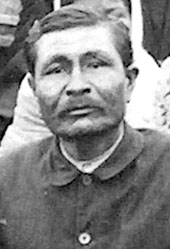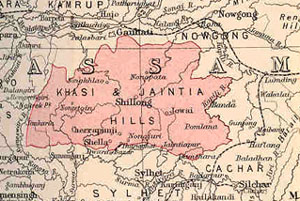
Hajom Kissor Singh (June 15, 1865-November 13, 1923) was born and lived all his life in the Khasi Hills of the state of Meghalaya in northeastern India. With no knowledge of the faith in other lands, he became a unitarian through his own studies. After communication with American and other Unitarians, he founded a Unitarian church in the town of Jowai, now the headquarters of the Indian Council of Unitarian Churches (ICUC). Singh led a growing Unitarian movement in his state where there are now more than 30 churches having some 10,000 members.
Kissor was the older of two sons of Bor Singh, a police sergeant in Jowai, a town in the mountainous, northeastern most corner of India where the Jaintia Hills and the Khasi Hills meet. The Khasi people, a tribe that had come to India from Southeast Asia, had their own non-Hindu religion featuring belief in a creator God, and whose shamanistic practice was based upon the propitiation of good, evil, and ancestor spirits. “In the Khasi religion at present,” Singh wrote in 1891, “there are thousand of demons and many rites and customs. I believe our forefathers had few demons; and I have heard from old people that at first our forefathers worshipped and offered sacrifices to God and not to demons.”

Until about 25 years before Kissor’s birth, the Khasi language had no script. Welsh Calvinistic Methodist missionaries created the first Khasi text when they produced a Khasi translation of the Bible. Thereafter, they opened the first Khasi schools and printed primers and a book of grammar.
At age 15 Singh converted to the Reform faith of the Welsh missionaries. By the time he reached the age when he might have matriculated from college, he had acquired the means of self-education. He was a good student, especially of religion. This led him to become a “questioning member” of the Methodist church, doubting orthodox Christianity. He recorded his difficulties, concerns, and original thinking in a diary which demonstrates a keen mind, precocious wisdom, and compassion.
Singh observed that the Welsh missionaries had done away with fear of demons, only to replace it with fear of hell. He deplored their hostility to Catholic missionaries wishing to settle in the Khasi Hills, as well as their unfriendliness to himself when he concluded from his studies that he would have to leave their church to seek “the true religion of Jesus, the love of God.”
Margaret Barr, a British Unitarian, served the Khasi Unitarian Community after Singh’s time. She wrote of his religious outlook, “He felt and declared that the message of election, damnation, and salvation—by going to a certain church and profession of a certain creed—was incompatible with the teachings of Jesus as he read for himself in the Gospels . . . He tried to persuade his fellow Christians that the essence of Christianity was to be found in Christ’s way of life and scale of values and not in any scheme of salvation by blood or faith . . . whether Pauline or Calvinistic.”
Young Singh had reached classic Unitarian convictions and had begun appealing to others to see their merit, without knowing that anyone else in the world thought as he did. When he was 25, he learned from a Brahmo convert (a member of the liberal Hindu Brahmo Samaj—or Society of Brahman) of Charles Henry Appleton Dall, an American Unitarian minister in Calcutta. Dall, Singh was told, thought as he did. There soon ensued an excited exchange of letters between the two men. Dall sent a volume of the writings of William Ellery Channing. Singh suddenly understood that many others, called Unitarians, shared his faith. Thereafter he called his faith “Ka Niam Untarian” (The Unitarian Religion.)
Singh began gathering friends in his home for religious discussion. Dall continued to write to him, encouraging his efforts, and also sent more Unitarian publications. After Dall died in 1886 Singh was grief stricken and discouraged by the loss. “I confess that I have got great light from him,” he recorded in his diary. “I hope to further the cause of . . . Unitarianism in the Khasi Hills but now that my helper has died it will be very difficult to do this alone.”
According to Singh’s biographer, before receiving Dall’s help he already had vision and faith, but he had lived in an intellectual vacuum and was much in need of links to a larger world of religious thought and history. Helen Tomkins took charge of the Unitarian Mission of the American Unitarian Association (AUA) after Dall’s death. She sent Singh copies of the Unitarian Magazine. He soon wrote to the magazine’s editor, Jabez T. Sunderland, who sent more literature.
On September 18, 1887, an anniversary date Khasi Unitarians celebrate, Singh led the first real church service in his home in Jowai. One woman and two men joined him as the first members of a new church. Around this same time U. Heh Pohong, a man who lived about 20 miles away in the village of Nongetalong, received Channing’s writings and also broke from Calvinism. A little later a Khasi pastor, David Edwards, in the village of Raliang, became Unitarian and left his pastorate. These three joined their efforts to promote, “a religion which they could preach with conviction.” Of the three Kissor Singh was best educated, as well as a natural leader of great ability.
A statement of faith was adopted by the Khasi Unitarians, and reported in 1888 by Singh in the Unitarian: “We believe (1) in the unity of God; (2) in the Fatherhood and Motherhood of God; (3) in the Brotherhood of Man; (4) in Love, Union, Worship, and Faith; and (5) in Immortality.”
Sunderland was a source of major assistance to the Khasi Unitarians. He solicited funds from Helen Bates and others of Waterville, Maine and used the money to publish 500 copies of Singh’s A Book of Services and Hymns in the Khasi Language, 1892. Funds from London were used for publication of several tracts in Khasi in 1893. By 1889 the Jowal congregation had gained 30 members who acquired a church building. They soon opened an elementary school, teaching in the Khasi language.
Singh and Sunderland met in 1896. Sunderland wrote, “I have never been more impressed with any religious movement than this in the Khasi Hills. Everywhere I saw evidences, sincerity, consecration and warm attachment to the religious faith which the people had felt had done so much for them. The whole movement is unique in the fact that it has sprung from the soil. It is my privilege to aid in the formation of a Khasi Hills Unitarian Union.”
By the end of 1899 Khasi Unitarians under Singh’s leadership numbered 214, with an average attendance at services of 148. He wrote a catechism, The Book of Brief Questions About Unitarianism, which has only recently been translated in English. Adapting some of the traditional values of Khasi culture, Singh defined Khasi Unitarianism in terms of duty to God, to fellow humans, and to oneself.
Magnus Ratter, a British minister, wrote of Singh’s many skills. An amateur medicine dealer, he provided medicine for the ill. A member of the board of the local Khasi bank, he siezed upon real estate bargains and bought houses the Unitarians could use. A surveyor, he was eventually head clerk in the deputy commisioner’s office in Shillong. Filling all these roles, he also did the work of his ministry, leading many services and giving much counsel.
Kissor Singh’s pioneering and eminently successful life was not without tragedy. Several members of his much-loved young family died, first his wife and then their children. He was left to raise alone a son and three daughters. He hoped his son, Ekiman Singh, might be a successor in his ministry. When the boy was 15, Singh sent him to the United States to study. The young man was not able to thrive in a culture so different from his own. He died of pneumonia in 1923.
Sources
Information about Singh can be found in Bruce Findlow, Kharang (1955); Mary Lawrance, “Khublei,” The Story of the Khasi Hills Liberal Churches (1964); Spencer Lavan, Unitarians and India (1977); Renewlet Nongbri, Growth and Development of Unitarianism in the Khasi and Jaintia Hills (1989); and John Rex, “Khasi Unitarians of North East India,” unpublished paper, Harper’s Ferry Ministerial Study Group (November 1999). For additional background on the Khasi people, language, and culture see Edingson Blah, Khasi Self-Teacher (1964); Hamlet Bareh, The History and Culture of the Khasi People (1967) and Khasi Fables and Folk Tales (1971); Margaret Barr, A Dream Come True (1974); and Hipshon Roy, editor, Khasi Heritage: A Collection of Essays on Khasi Religion and Culture (1979).
Article by Spencer Lavan
Posted November 1, 2003